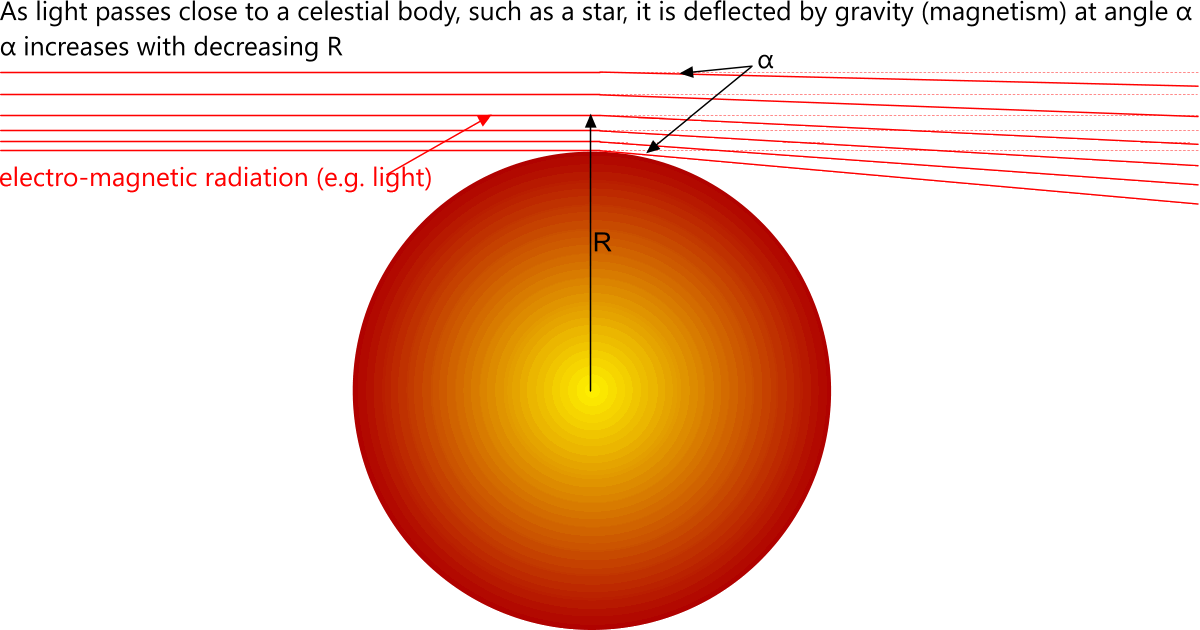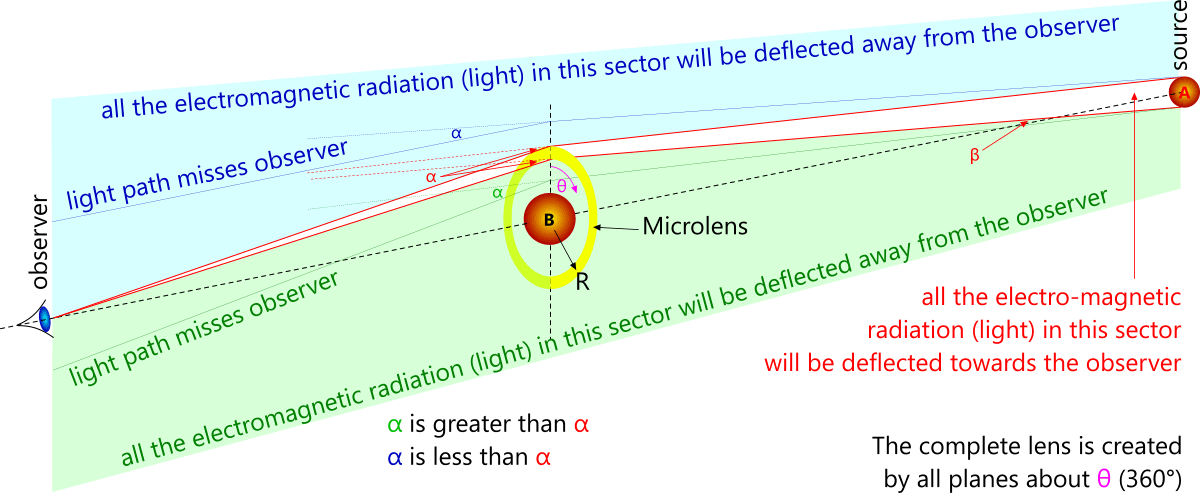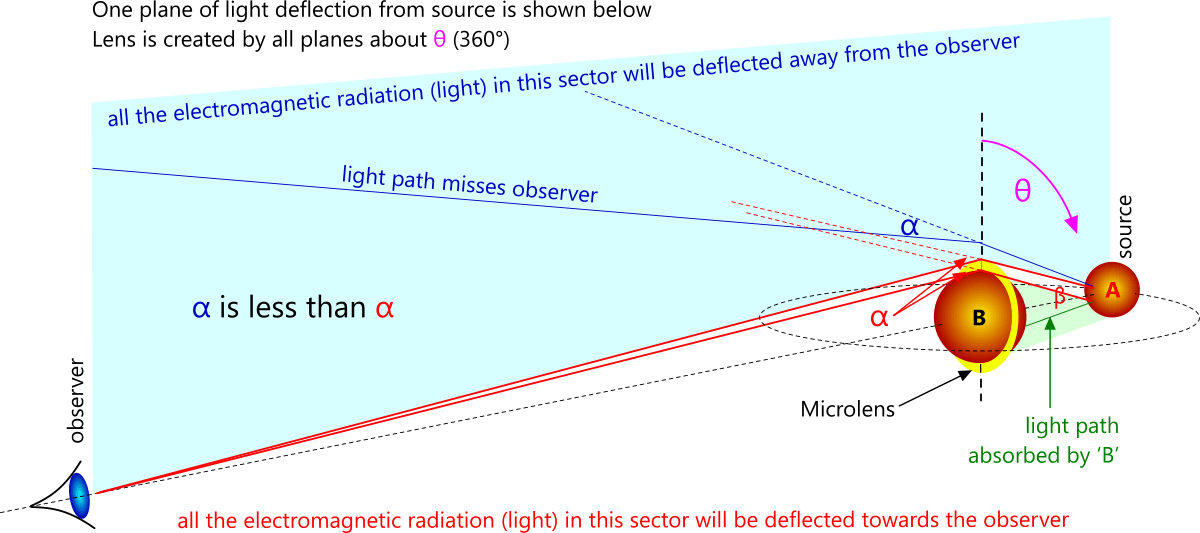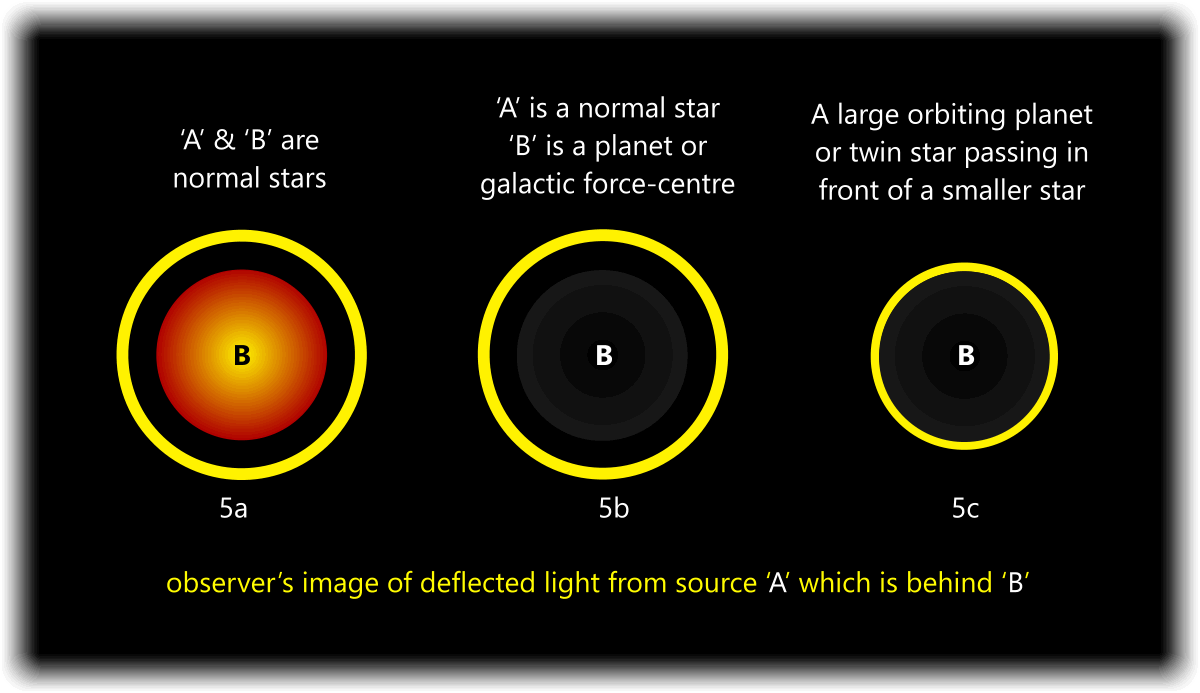The Astrolens (its cause and effect)
The term astrolens is more popularly known as microlens, which is a little misleading, it would seem more appropriate to call it a 'macro', 'halo' or 'anulus' lens.
What is referred to as a microlens is caused by the magnetic (gravitational) deflection of light (Fig 1) radiated by a source situated behind (hidden by) a star you are observing (Fig 2). Its effect will be of the observed star surrounded by a ring of light (Fig 5a).

It is important to understand that this phenomenon has nothing to do with Relativity. It is a perfectly natural event caused by the deflection of electro-magnetic radiation passing close to a large body, such as a planet or star. To make this phenomenon work using his own formulas, Einstein had to deform space/time around celestial bodies. If his theories are used without deforming space/time, the microlens would appear inside the observed star. Moreover, this phenomenon was originally predicted by Orest Khvolson and Frantisek Link, not Einstein.
An Explanation
When passing a large (celestial) body, electro-magnetic energy is deflected by its magnetic charge (gravitational energy). The angle at which the light is deflected (α) may be calculated using Isaac Newton's gravitational constant (G) as follows:
α = Atan(4.aₒ.Vs / R) ©
Note: G = aₒ.c² / mᵤ = 6.67359232004332E-11 {m³/kg/s²} ©

We shall refer to your eye as the observer, the source as star 'A' and the intermediate (or blocking) body as star 'B' (Fig 2)
Light from 'A' is radiated in all directions. If it wasn't blocked by 'B', it would appear to the observer as a normal star because all of the light that reaches the observer will travel in a straight-line, just as occurs with the light from 'B'.
However, you would not expect to see 'A' because it is hidden behind 'B', which you will see exactly as it is; a circular body (e.g. a star)
So why doesn't this phenomenon appear to occur in our everyday life? For example; when looking towards an object (a source) that is blocked by another, microlensing doesn't appear to occur because the magnetic charge (gravitational energy) in the blocking object is insufficient to noticeably deflect the light radiated by the source. But it is there, it is just too weak to generate a visible microlens.

If the angle of the electro-magnetic energy radiated from 'B' is just right (Fig 3; β), the deflected angle (α) will cause the electro-magnetic radiation to be directed at the observer. All the electro-magnetic radiation that is not emitted by 'A' at angle 'β' will not reach the observer. It will be deflected away from (below or above in the plane shown) the observer's location. Therefore, the region inside and outside the ring will appear black (Fig 5a). The reason a microlens anulus has a thickness is due to the diameter of 'A', as can be seen in Fig 3
If 'B' is a dead star or galactic force-centre, the inside of the microlens will appear all black (Fig 5b).

Apparent Size Variation
Another manifestation of this phenomenon is for a smaller, hidden star to appear larger than the star in front of it. Exactly the same light deflection is taking place here but the bodies concerned are much closer together; e.g. one of them is in orbit around the other (Fig 4).
In this case, 'R' will be significantly less than above (Fig 3) and the deflection much greater. And whilst the same lens will appear around 'B', it will appear at its surface, giving the appearance of a larger star behind it. In this orbital situation, one of the stars concerned is invariably dark, which is due to one of the bodies being a large planet, or a dark star.:
In 1784, John Goodricke discovered the [supposed] binary nature of the star originally named Algol. As one of the binary stars passed in front of the other, their combined brightness dimmed, revealing two important facts:
1) One of the stars was bright (hot) and the other was dark (cold)
2) Only the bright star was a force-centre for an orbital system
The dark(er) star (or large planet) is actually in orbit around the bright-star but has no significant satellite population of its own, so it cannot generate internal heat.
Once a star (force-centre) has acquired its satellites, it can trap a twin but it will not share its satellites, reinforcing the fact that stars generate their own internal heat from their satellite population.
Therefore, in the case of binary stars, if a smaller bright star passes behind a larger dark star lensing will still occur, but the entire centre of the ring will appear dark (Fig 5c).

Fig 5 shows a number of lensing images as they might appear to an observer:
a): lensing that would be expected when the two stars concerned (a source star ('A') behind an observed star ('B')) are widely separated.
b): the same lensing condition as described for a) but the observed star is dark; either a galactic force-centre or a star with too few planetary satellites to generate internal fissionable heat.
c): the same lensing condition as described for a) but the bodies are much closer together, one of which is in orbit around the other - one will be dark and the other bright. The view shown here is when the dark body is directly between the bright body and the observer.
Further Reading
You will find further reading on this subject in reference publications(68)